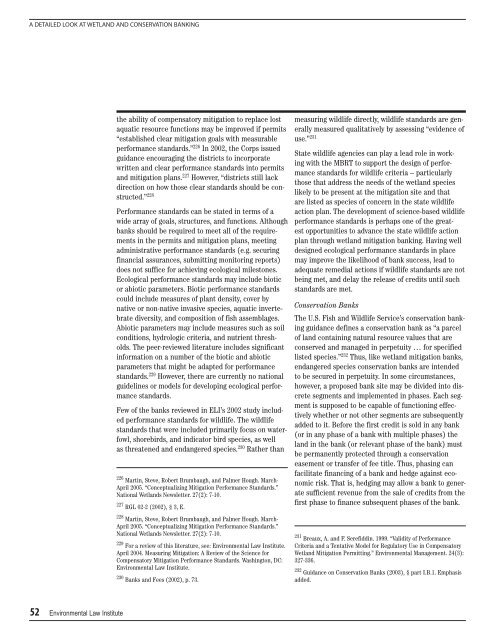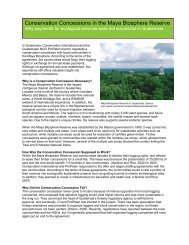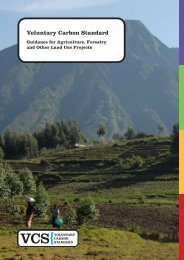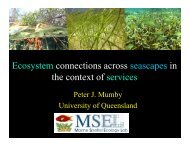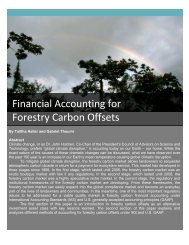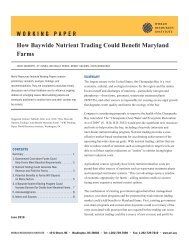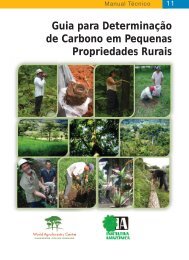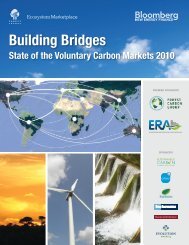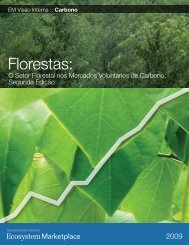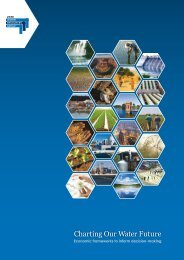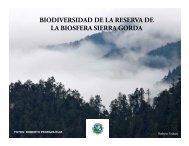Design of US Habitat Banking Systems to Support the Conservation ...
Design of US Habitat Banking Systems to Support the Conservation ...
Design of US Habitat Banking Systems to Support the Conservation ...
You also want an ePaper? Increase the reach of your titles
YUMPU automatically turns print PDFs into web optimized ePapers that Google loves.
A DETAILED LOOK AT WETLAND AND CONSERVATION BANKING<strong>the</strong> ability <strong>of</strong> compensa<strong>to</strong>ry mitigation <strong>to</strong> replace lostaquatic resource functions may be improved if permits“established clear mitigation goals with measurableperformance standards.” 226 In 2002, <strong>the</strong> Corps issuedguidance encouraging <strong>the</strong> districts <strong>to</strong> incorporatewritten and clear performance standards in<strong>to</strong> permitsand mitigation plans. 227 However, “districts still lackdirection on how those clear standards should be constructed.”228Performance standards can be stated in terms <strong>of</strong> awide array <strong>of</strong> goals, structures, and functions. Althoughbanks should be required <strong>to</strong> meet all <strong>of</strong> <strong>the</strong> requirementsin <strong>the</strong> permits and mitigation plans, meetingadministrative performance standards (e.g. securingfinancial assurances, submitting moni<strong>to</strong>ring reports)does not suffice for achieving ecological miles<strong>to</strong>nes.Ecological performance standards may include bioticor abiotic parameters. Biotic performance standardscould include measures <strong>of</strong> plant density, cover bynative or non-native invasive species, aquatic invertebratediversity, and composition <strong>of</strong> fish assemblages.Abiotic parameters may include measures such as soilconditions, hydrologic criteria, and nutrient thresholds.The peer-reviewed literature includes significantinformation on a number <strong>of</strong> <strong>the</strong> biotic and abioticparameters that might be adapted for performancestandards. 229 However, <strong>the</strong>re are currently no nationalguidelines or models for developing ecological performancestandards.Few <strong>of</strong> <strong>the</strong> banks reviewed in ELI’s 2002 study includedperformance standards for wildlife. The wildlifestandards that were included primarily focus on waterfowl,shorebirds, and indica<strong>to</strong>r bird species, as wellas threatened and endangered species. 230 Ra<strong>the</strong>r than226 Martin, Steve, Robert Brumbaugh, and Palmer Hough. March-April 2005. “Conceptualizing Mitigation Performance Standards.”National Wetlands Newsletter. 27(2): 7-10.227 RGL 02-2 (2002), § 3, E.228 Martin, Steve, Robert Brumbaugh, and Palmer Hough. March-April 2005. “Conceptualizing Mitigation Performance Standards.”National Wetlands Newsletter. 27(2): 7-10.229 For a review <strong>of</strong> this literature, see: Environmental Law Institute.April 2004. Measuring Mitigation: A Review <strong>of</strong> <strong>the</strong> Science forCompensa<strong>to</strong>ry Mitigation Performance Standards. Washing<strong>to</strong>n, DC:Environmental Law Institute.230 Banks and Fees (2002), p. 73.measuring wildlife directly, wildlife standards are generallymeasured qualitatively by assessing “evidence <strong>of</strong>use.” 231State wildlife agencies can play a lead role in workingwith <strong>the</strong> MBRT <strong>to</strong> support <strong>the</strong> design <strong>of</strong> performancestandards for wildlife criteria – particularlythose that address <strong>the</strong> needs <strong>of</strong> <strong>the</strong> wetland specieslikely <strong>to</strong> be present at <strong>the</strong> mitigation site and thatare listed as species <strong>of</strong> concern in <strong>the</strong> state wildlifeaction plan. The development <strong>of</strong> science-based wildlifeperformance standards is perhaps one <strong>of</strong> <strong>the</strong> greates<strong>to</strong>pportunities <strong>to</strong> advance <strong>the</strong> state wildlife actionplan through wetland mitigation banking. Having welldesigned ecological performance standards in placemay improve <strong>the</strong> likelihood <strong>of</strong> bank success, lead <strong>to</strong>adequate remedial actions if wildlife standards are notbeing met, and delay <strong>the</strong> release <strong>of</strong> credits until suchstandards are met.<strong>Conservation</strong> BanksThe U.S. Fish and Wildlife Service’s conservation bankingguidance defines a conservation bank as “a parcel<strong>of</strong> land containing natural resource values that areconserved and managed in perpetuity … for specifiedlisted species.” 232 Thus, like wetland mitigation banks,endangered species conservation banks are intended<strong>to</strong> be secured in perpetuity. In some circumstances,however, a proposed bank site may be divided in<strong>to</strong> discretesegments and implemented in phases. Each segmentis supposed <strong>to</strong> be capable <strong>of</strong> functioning effectivelywhe<strong>the</strong>r or not o<strong>the</strong>r segments are subsequentlyadded <strong>to</strong> it. Before <strong>the</strong> first credit is sold in any bank(or in any phase <strong>of</strong> a bank with multiple phases) <strong>the</strong>land in <strong>the</strong> bank (or relevant phase <strong>of</strong> <strong>the</strong> bank) mustbe permanently protected through a conservationeasement or transfer <strong>of</strong> fee title. Thus, phasing canfacilitate financing <strong>of</strong> a bank and hedge against economicrisk. That is, hedging may allow a bank <strong>to</strong> generatesufficient revenue from <strong>the</strong> sale <strong>of</strong> credits from <strong>the</strong>first phase <strong>to</strong> finance subsequent phases <strong>of</strong> <strong>the</strong> bank.231 Breaux, A. and F. Serefiddin. 1999. “Validity <strong>of</strong> PerformanceCriteria and a Tentative Model for Regula<strong>to</strong>ry Use in Compensa<strong>to</strong>ryWetland Mitigation Permitting.” Environmental Management. 24(3):327-336.232 Guidance on <strong>Conservation</strong> Banks (2003), § part I.B.1. Emphasisadded.52 Environmental Law Institute


